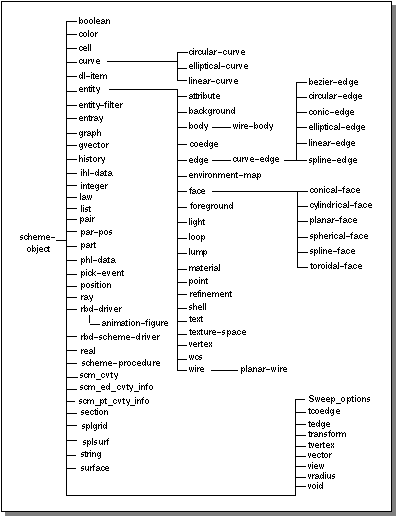|
ACIS defines a set of data types and methods for the native Scheme language. Data types and methods do the following:
|
|

|
Determine if a Scheme object (ScmObject) is an object of a particular type.
|

|
Convert a Scheme object into the corresponding
C++ object.
|

|
Convert a
C++ object into the corresponding Scheme object.
|

|
Evaluate Scheme expressions from
C++.
|

|
Enable application developers to define their own new data types and Scheme procedures.
|
|
|
For descriptions of the data types that
ACIS provides, refer to their reference templates.
|
|
|
Scheme AIDE provides data types specifically for use with
ACIS Scheme extensions, in addition to those that are native to Scheme. These data types are described in online help. Some data types are specific to
ACIS, such as
entity,
pick-event, and
gvector. Other data types are native to Scheme, such as
boolean,
integer, and
real. Native data types are documented in online help only if they are needed to describe the
ACIS data types.
|
|
|
The reference template for Scheme extensions includes an
Arg Types field that specifies the data type of each object passed into the extension and a
Returns field that specifies the data type of the object returned by the extension. In some cases, the return of an extension is unspecified, and the
Returns field contains the word
unspecified. This is not an actual data type, only an indicator of the lack of a specified data type returned by the extension.
|
|
|
At their highest level, all Scheme object data types are
scheme-objects. When an
ACIS Scheme extension is invoked, a
C++ handler procedure generally converts the
scheme-object arguments to their corresponding
C++ types, performs
ACIS or other operations, then converts the result back to a
scheme-object, which is returned by the extension.
|
|
|
At their next highest level, many types of arguments are
entitys. entity objects are saved and restored as part of the model and are referred to as
persistent. Non-entity objects are not saved and restored as part of the model (they are lost when
Scheme AIDE is terminated) and are referred to as
transient.
|
|
|
At more specific levels, many types of arguments are really
subtypes of
entity. For example,
body,
lump,
shell,
face,
coedge,
edge,
vertex, and
wire are all topological subtypes of
entity.
|
|
|
Figure 3-1 graphically depicts the data type relationships. An item in the tree is read from right to left. For example, a
circular-edge is a
curve-edge that is an
edge that is an
entity that is a
scheme-object. Individual derivations are shown in each data type's description.
|
|

|
|
|
Figure 3-1. Scheme Data Type Relationships
|
|
|
Data types immediately derived from
scheme-object that have unique external representations are
true data types implemented in Scheme or in extensions. Other data types without distinct external representations are not true data types, but
subclassifications used only as a convenience for the purposes of discussion.
|